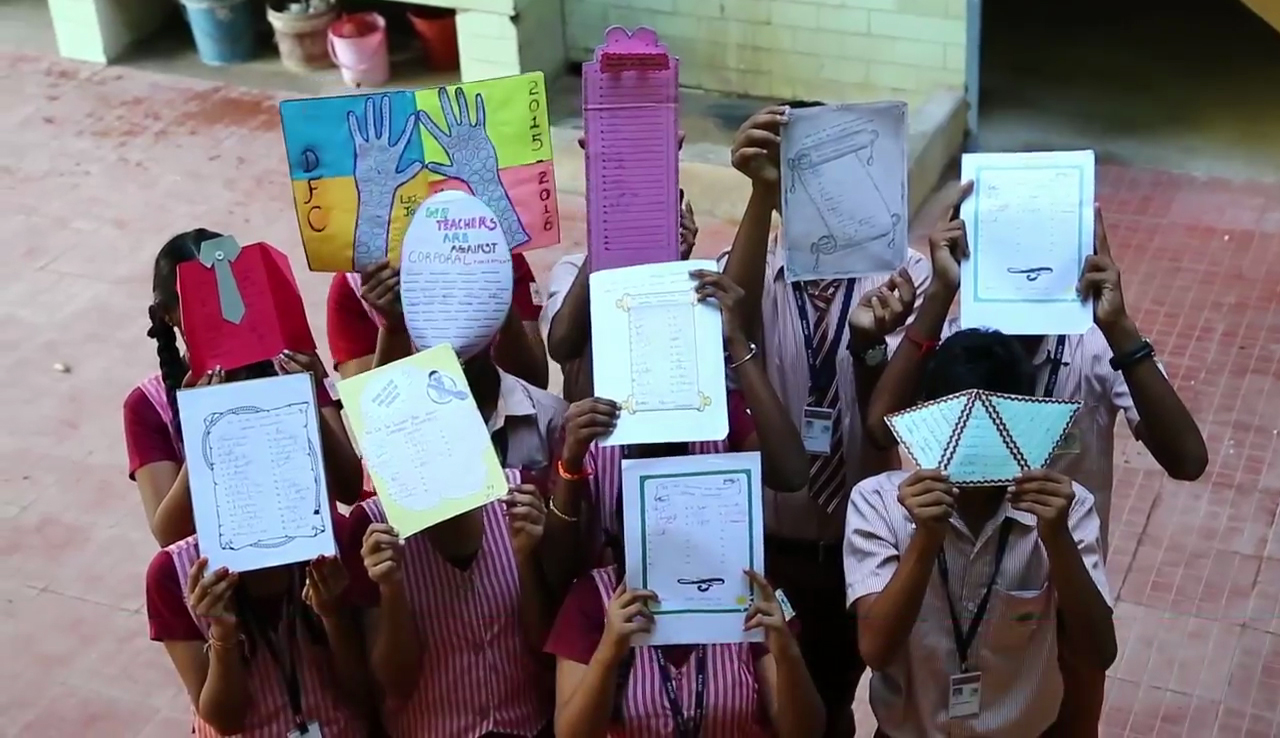TBI Blogs: These TN Students Have Come up with 6 Creative Solutions to Fight Corporal Punishment in Schools
Disturbed by deaths caused by teachers hitting students, these 11th-graders in Tamil Nadu designed creative solutions to introduce positive discipline in the classroom, in lieu of punishment. The project won the ‘Bold & Audacious’ award at the ‘I CAN Awards 2015’ organised by Design for Change.

In the aftermath of yet another student death caused by corporal punishment, a group of Class XI students at Kaligi Ranganathan Montford Matriculation Higher Secondary School in Chennai, Tamil Nadu decided to address the issue in their own district. They were disturbed by the widespread phenomenon of corporal punishment – the act of hitting students as punishment, or as a means to change their behaviour – in schools around the world. Knowing that learning cannot happen in fear, the students set about designing healthy alternatives to physical punishment so as to reduce conflicts in student-teacher relationships.
They studied the impact – the mental and emotional pain – of corporal punishment on children, spoke to principals of nearby schools, and met psychiatrists and psychologists like Dr. Padma Chandrashekhar to know how violence adversely impacts a child’s mind. Not only does corporal punishment harbour feelings of insecurity and diminished self-esteem in a child, but aggression is also known to breed further aggression, with children who suffer violence being far more likely to inflict violence or bully others in the future.
A former victim of corporal punishment himself, filmmaker Bramma G – whose film Kuttram Kadithal won the National Film Award for Best Feature Film in Tamil in 2015 and portrays corporal punishment – also discussed solutions with the students.
The students then embarked on designing healthier alternatives to such punishment, and came up with six creative solutions.
They designed an ‘Affirmative Discipline Wheel’ for every classroom so that a student can choose his own punishment by turning the wheel, from amongst options like having to take down notes for another classmate to adopting additional responsibilities in school.

Penalty cards given by teachers – like a yellow card to send someone for counselling – replaced the physical act of hitting. To encourage teachers to communicate their feelings in the classroom more positively, they created placards with ‘happy and sad faces’.

Instead of receiving physical punishment, students were prompted to reflect on their own actions and change their behaviour.
To encourage this self-realisation, they created ‘Attitude Mirrors’ with thoughtful quotes like “I am a reflection of my attitude” as prompts for reflection. To create a more positive environment amongst students and teachers, they installed several Appreciation Boxes on trees and poles around the campus to share love and appreciation towards teachers. The students installed Confession Boxes to urge people to admit to their own mistakes.

The students went to various schools to demonstrate their projects to the teachers and students.
Inspired by these ideas, 500 teachers vowed to not use corporal punishment through a signature campaign.
At the same time, there were many schools that refused the students entry, insisting that using the cane is the only way to enforce discipline. The students, however, persisted with optimism, by demonstrating to even the staunchest advocates of corporal punishment that affirmative discipline works.

The then headmistress Anitha Daniel, who is a firm advocate against corporal punishment, recounts how the students were initially afraid about pursuing this project, fearing retribution from their teachers. But adopting the simple 4-step design-thinking framework of Design for Change – a not-for-profit organisation that challenges children to solve problems in their community – the students went about step by step addressing the issue.
DFC’s FIDS framework encourages children to first ‘feel’ for an issue, then ‘imagine’ a way out of it. They then ‘do’ something about it, and go on to ‘share’ their idea with more people.
The project went on to win in the ‘Bold and Audacious’ category award from amongst 2,512 stories submitted in 2015. You can watch their full story here:
Unfortunately, it’s been estimated that 65 % of school-going children suffer under corporal punishment in India, according to a 2007 study by the Ministry of Women & Child Development, Government of India. Though it is now a punishable offence, it is still rampant in many classrooms, which requires serious intervention. Students at Kaligi Ranganathan School remind us that the power rests within us to believe that positive methods work. Punishment is a concept of the past, and we must speak up for those who cannot.
Be a part of one of the largest global movements of children driving change in their communities. Take up the ‘I CAN School Challenge’ in your classroom. Find out more online or reach out to Design for Change on +91 9599916181.
Like this story? Or have something to share?
Write to us: [email protected]
Connect with us on Facebook and Twitter.
NEW: Click here to get positive news on WhatsApp!
If you found our stories insightful, informative, or even just enjoyable, we invite you to consider making a voluntary payment to support the work we do at The Better India. Your contribution helps us continue producing quality content that educates, inspires, and drives positive change.
Choose one of the payment options below for your contribution-
By paying for the stories you value, you directly contribute to sustaining our efforts focused on making a difference in the world. Together, let's ensure that impactful stories continue to be told and shared, enriching lives and communities alike.
Thank you for your support. Here are some frequently asked questions you might find helpful to know why you are contributing?


This story made me
-
97
-
121
-
89
-
167














